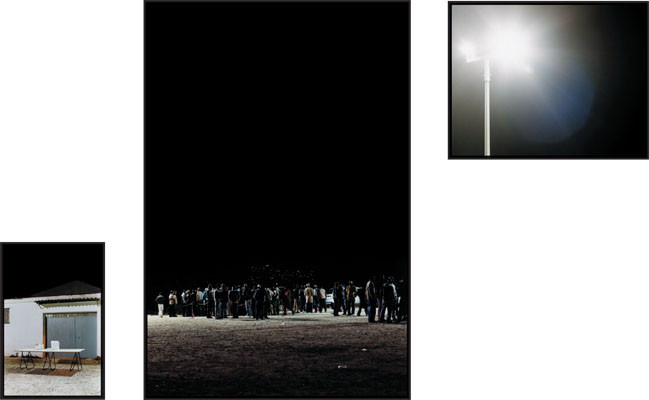Ulrich Gebert - Amerika
02 Nov - 15 Dec 2007
Ulrich Gebert's work revolves around terms that seem at first abstract and intangible, but which define substantially social thinking and action. In his artistic context he maps pointedly and makes comprehensive the problems of thinking in systems, hierarchies, and mechanisms of power. When “Ulrich Gebert conceives his series of photographs on normative categories and modern fantasies of order, the pictures are always accompanied by the certainty of their own constructedness.” In his meta-phoric image-cycles and series he pursues fictive documentations of crime or the human drive of grasping our environment and taming nature. He finds images for what is often unspeakable. Depending on the context he avails himself on staged, filmic, documentary or portrait-like methods of depiction in order to find the con-structions and contents of his images. Ulrich Gebert combines this media-referential approach with the mindset of a critically thinking artist.
For his current work he has scrutinized the organization and working processes during the orange harvest in Southern Spain and developed an image-cycle of three parts. As in former works the relation of man towards nature plays a crucial role. Like this “topos (...) was the quintessential Romantic motif, used by artists of the period to oppose the alienating effects of industrialisation, for Gebert, this relationship seems to become a medium through which to describe the role of the individual within glob-alisation and turbo-capitalism”. When ‘Freischneider’ (2003) and ‘Typus’ (2005) still had a laconic-sarcastic undertone, ‘Amerika’ turns into a place, where “the ways people treat each other, the mechanisms of their power and control over one another, are played out.” This conflation also reflects formally in his work. We are witnesses of a systematic transport, organization and employment process, in which the individual moves to the background and is about to be swallowed by ist environment. The small-sized images of part 1 encounter us as an almost filmic sequence. Shot from a distance and appearing almost graphical the images densify in the middle of the series. In contrast to it, the lush tableaus of ripe oranges in part 2 do not offer any point on which the eye can concentrate. The images convey in their presence a metaphor of abundant nature that seems almost paradisiacal in its richness and beauty. As if souled with personality it steps out from the images and provides a glimpse of its entropic char-acter after the imago of the first impression. The final triptyche reinforces consistently this notion. It takes the spectator back to civilization and darkness. Only illuminated by the cold glow of the spotlight an assembly point can be detected where a bare desk stands lonely as a metaphor of the latently present system of order.
Without lurid impetus trusting the small-sized format and the mechanisms of seeing and understanding Ulrich Gebert lines up a microcosm that points to social coherences questioning sustainably the motive of longing for the land of honey and milk.
Opening times: Tue - Sat, 11-18 h
For his current work he has scrutinized the organization and working processes during the orange harvest in Southern Spain and developed an image-cycle of three parts. As in former works the relation of man towards nature plays a crucial role. Like this “topos (...) was the quintessential Romantic motif, used by artists of the period to oppose the alienating effects of industrialisation, for Gebert, this relationship seems to become a medium through which to describe the role of the individual within glob-alisation and turbo-capitalism”. When ‘Freischneider’ (2003) and ‘Typus’ (2005) still had a laconic-sarcastic undertone, ‘Amerika’ turns into a place, where “the ways people treat each other, the mechanisms of their power and control over one another, are played out.” This conflation also reflects formally in his work. We are witnesses of a systematic transport, organization and employment process, in which the individual moves to the background and is about to be swallowed by ist environment. The small-sized images of part 1 encounter us as an almost filmic sequence. Shot from a distance and appearing almost graphical the images densify in the middle of the series. In contrast to it, the lush tableaus of ripe oranges in part 2 do not offer any point on which the eye can concentrate. The images convey in their presence a metaphor of abundant nature that seems almost paradisiacal in its richness and beauty. As if souled with personality it steps out from the images and provides a glimpse of its entropic char-acter after the imago of the first impression. The final triptyche reinforces consistently this notion. It takes the spectator back to civilization and darkness. Only illuminated by the cold glow of the spotlight an assembly point can be detected where a bare desk stands lonely as a metaphor of the latently present system of order.
Without lurid impetus trusting the small-sized format and the mechanisms of seeing and understanding Ulrich Gebert lines up a microcosm that points to social coherences questioning sustainably the motive of longing for the land of honey and milk.
Opening times: Tue - Sat, 11-18 h

